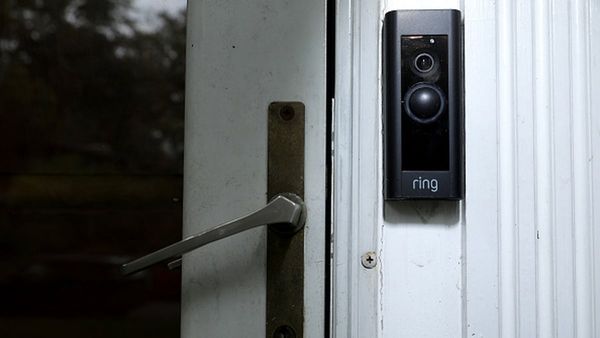
As a young child, artist Janet Dawson learned to see the world through her mother’s eyes, the eyes of a woman who could find wonder in both the cosmos and the kitchen.
“She took me out in the early evening and explained the moon,” Dawson recalls, graciously holding court from her wheelchair at the Art Gallery of New South Wales (AGNSW) on Friday. “She taught me that the moon had a job to do – to rise and to return. She gave it purpose, and so I watched it carefully and waited for it every night.”
That nightly ritual sparked Dawson’s lifelong fascination with contrast: the vastness of the sky against the intimacy of domestic life.
“It was my first idea of waiting for something big,” she says. “And then we’d go into the kitchen – so small, so detailed.”
It is therefore fitting that her embarrassingly long-overdue first ever retrospective – at the age of 90 – is titled Janet Dawson: Far Away, So Close. The exhibition, spread across four rooms at the AGNSW, spans more than six decades of the Australian artist’s work.
There are her teenage years at the National Gallery of Victoria Art School (at the precocious age of 11, she became the only child student accepted by realist painter H Septimus Power), and her formative years as an abstract painter while studying in the UK, France and Italy. And then her defiantly unconventional art practice built in conservative 1960s Melbourne, and her retreat to the quiet beauty of rural NSW, a property she shared with her husband, the theatre director and playwright Michael Boddy, in the 1970s.
A 1973 portrait of Boddy, who died at the couple’s Scribble Rock property in the southern tablelands in 2014, saw Dawson become only the third female artist to win the Archibald prize.
“Janet Dawson is a rare figure in Australian art history,” the AGNSW’s director, Maud Page, said at Friday’s preview of Far Away, So Close. “This exhibition shows that not only was she a formal innovator, but a deeply perceptive observer of the world around her, always alert to the play of light, energy, of nature and immediacy.
“It’s a celebration of a visionary artist whose work continues to shape Australian art.”
Dawson’s retrospective, which includes photos, media coverage and other ephemera as well as major works, moves across the four rooms chronologically.
“Janet was continuously rethinking and reworking ideas,” says curator Denise Mimmocchi. “And so each stage of her career comes across as something very distinct.
“Someone said to me, it’s like an exhibition of four different artists. But I like to think that there is a very strong thread throughout the four rooms … an incredible underlying energy to these works. They’ve got such power. I spend my time looking at a lot of paintings, and I don’t think I’ve ever encountered ones that have this pulsating, underlying grab to them.”
‘I was a working creature’
Dawson’s early mastery of tonal realism is evident in the very first work of the exhibition, an exquisite self-portrait she painted at just 18. To its immediate right, an inkling of what would become the mercurial nature of the artist’s style – a post-cubist style pigeon, also painted around the same time.
A traveling art scholarship to Europe saw Dawson abandon realism and embrace abstraction. It was there that she “started to understand her own visual language – one rooted in movement, emotion and fearless exploration,” says Mimmocchi.
When Dawson returned to Melbourne, she was a daring abstract female artist working in a conservative and male-dominated figurative art culture.
Large-scale works in the 1960s such as St George and the Dragon and The Origin of the Milky Way soon earned Dawson the reputation of an artist who refused to stick to the rules. By the late 1960s she had embraced, then subverted, colour-field painting, whose most well-known proponent, Mark Rothko, championed wide swathes of unmodulated colour across expansive canvases.
Dawson soon began defying the flatness of the colour-field genre, says Mimmocchi, introducing in works such as Rollascape 2, an “underlying pulsation of light”, and making a style unmistakably her own.
A move to Sydney saw Dawson becoming increasingly captivated by the beauty of natural environments, with her series of ripple paintings evoking what at first appears to be panoramic ocean views, yet with a subtle reference to the geometric abstraction of her previous practice.
This marked a turning point for the artist, says Mimmocchi, which saw “a closer immersion in the natural world – where fluctuations of light and atmosphere entered her abstract vocabulary.”
Her husband’s work in Sydney expanded her oeuvre to theatre design, producing sets for Boddy’s plays including The Legend of King O’Malley and Cash, and establishing a theatre in schools program.
“I was a working creature … living the art and living the drawing,” Dawson says, peering with delight into a display cabinet containing press clippings and theatre memorabilia from that time.
A job as a production assistant in the display department at the Australian Museum also expanded her interest in natural history. Her anatomical drawings of Australian fauna for the museum would go on to inform her detailed works of wildlife corpses, such as Hare on Blue, retrieved from Dawson and Boddy’s rural property, Scribble Rock.
It was there that Dawson began creating her Scribble Rock Red Cabbage series, a collection of kitchen still lifes that was bought in its entirety by the National Gallery of Australia.
And it was at Scribble Rock where she returned to her haunting studies of the moon, which once again became her night-time companion.
For some works, she painted what she saw with the assistance of technology, such as the 2000 work Moon at Dawn through a Telescope.
“The moon has this beautiful poetry about it anyway, but Janet creates it into something beautifully glowing and energetic that is very difficult to harness in a painting,” Mimmocchi says,
At the age of 90, Dawson’s exhibition is more than a retrospective. It is a celebration of a life lived through art, where nature and abstraction converge in luminous harmony, both informed by a keen and constant curiosity forged by a mother decades earlier, herself a talented artist who gave up painting to raise a family.
“But she never stopped teaching me, she showed me things constantly,” she says.
“And I think what that gave me was an openness of vision. I can look at anything and just look at it for itself. It doesn’t necessarily have to be a thing to be hung on the wall. It is, of itself.”
Janet Dawson: Far Away, So Close is on at AGNSW until 18 January 2026







